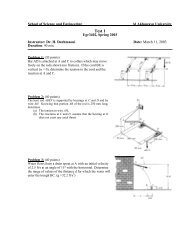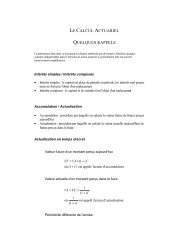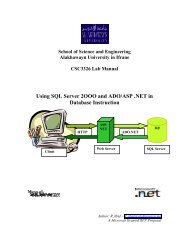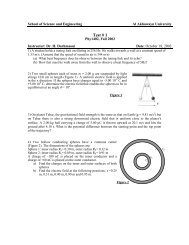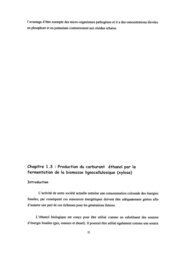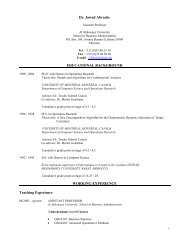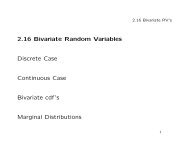Leadership and Values in Language Education - Al Akhawayn ...
Leadership and Values in Language Education - Al Akhawayn ...
Leadership and Values in Language Education - Al Akhawayn ...
- No tags were found...
You also want an ePaper? Increase the reach of your titles
YUMPU automatically turns print PDFs into web optimized ePapers that Google loves.
67Proceed<strong>in</strong>gs of the 27 th MATE Annual Conference‘discussion’ or ‘negotiation’ analysis <strong>in</strong> which case students are <strong>in</strong>vited toactively participate <strong>in</strong> discuss<strong>in</strong>g their needs <strong>and</strong> wants with their language<strong>in</strong>structors Students are therefore able “to make some recommendations as towhat should happen <strong>in</strong> the resultant course” (Rob<strong>in</strong>son, 1991:14). It is alsoessential to take students’ needs <strong>in</strong>to consideration whatever the clashes thatmight emerge between students’ personal needs <strong>and</strong> the teacher’s perceived needson the one h<strong>and</strong>, <strong>and</strong> between the students’ needs <strong>and</strong> the <strong>in</strong>stitutions’ needs onthe other, work<strong>in</strong>g collaboratively with a hope to meet the expectations of each(Larouz, 1996).Importantly, students will have the chance to be aware of their own needs <strong>and</strong>wants as well as their preferred styles of learn<strong>in</strong>g which are to be taken <strong>in</strong>toaccount by all the concerned. It could be suggested that there could be nolanguage development or syllabus development without negotiat<strong>in</strong>g with thestudents about what <strong>and</strong> how they wish to learn because <strong>in</strong>volv<strong>in</strong>g students <strong>in</strong>decision mak<strong>in</strong>g may provide <strong>in</strong>sights <strong>in</strong>to language learn<strong>in</strong>g <strong>and</strong> teach<strong>in</strong>g as wellas the mak<strong>in</strong>g of the textbook, as Kemmis <strong>and</strong> Mactaggart (1986:171) note“curriculum negotiation <strong>in</strong>volves giv<strong>in</strong>g students a voice <strong>in</strong> the choice <strong>and</strong>development of learn<strong>in</strong>g opportunities <strong>in</strong> the classroom: both the what <strong>and</strong> thehow of the curriculum.”Moreover, the role of the students needs to change. They should know that theyare responsible for their own learn<strong>in</strong>g <strong>and</strong> therefore should not be dependent toomuch on the teacher. The teacher is there to guide <strong>and</strong> to assist but most of thejob is done by the students themselves. They should change from ‘Jug learners’ to‘C<strong>and</strong>le learners’ (Scholfield, 1987). ‘Jug learners’ are those who regardthemselves as jugs to be filled with knowledge, that is, those who prefer toreceive knowledge from other people (from teachers) . ‘C<strong>and</strong>le learners’, on theother h<strong>and</strong>, are those learners who are regarded as c<strong>and</strong>les to be lit with ideas <strong>and</strong>then burn with their own light of learn<strong>in</strong>g, that is, those who br<strong>in</strong>g light tolearn<strong>in</strong>g. They are highly motivated to the extent that they can contribute <strong>and</strong>seek for knowledge. They do not wait for their teacher to feed them, but take the<strong>in</strong>itiative themselves. Hence, if most of our students prefer to be taughteveryth<strong>in</strong>g by the teacher, one should not be surprised as this is the sort ofeducation that used to be <strong>in</strong> the past <strong>and</strong> still exists not only <strong>in</strong> Morocco butprobably <strong>in</strong> most of the Arab world <strong>and</strong> The Third World <strong>in</strong> general where theteacher is the model, the ‘Mr know-all’ <strong>and</strong> students play only a passive role(Larouz, 1996). Perhaps this concept of <strong>in</strong>dividualisation <strong>in</strong> language teach<strong>in</strong>g<strong>and</strong> learn<strong>in</strong>g, “aims at provid<strong>in</strong>g as many permutations as possible to the learner





